How to clean the sewer pipe at home from clogging: solutions + prevention tips
Not every homeowner knows how to clean the sewer at home from clogging. Not everyone knows how to do this work quickly and efficiently, especially if you had to face this problem for the first time. Any problems with sewage systems are stress for the owners, all the more stable congestion, right?
We will help you with this task. In our article, we describe in detail the methods for determining the location of the cork and proven in practice ways to get rid of it. To help independent plumbers, photos and video recommendations for cleaning pipes using improvised tools are provided.
The content of the article:
Reasons for a clogged sewer
If you find that the water does not drain well and there is an unpleasant odor, then the resulting blockage is to blame. The smaller the problem, the easier and easier it is to get rid of it. Therefore, to begin with, you should determine the cause of the garbage jam.
Problem # 1 - accumulated fat
The fat deposited on the walls of the pipes from the dishes causes the majority (about 70%) of congestion. Most often, such a blockage appears in the kitchen: a sink, draining from a dishwasher are the most problematic areas.
Such accumulations are formed slowly: their inner layer is jelly-like, and the outer layer adjacent to the pipes is more knocked down. They are formed, in addition to fat, food particles, threads, etc.
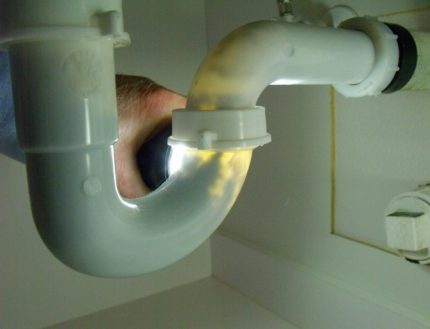
Problem # 2 - Heavy Waste
Particles that are heavy in weight provoke the occurrence of technogenic blockages. Of the total number of reasons, they make up no more than 10% and appear most often in apartment buildings.
They consider heavy: sand, rubbish from repairs, poorly washed solutions, filler for an animal toilet, hygiene products, rags, wet wipes, toilet paper and newspapers that enter the sewers through the toilet.
In addition, organic waste — vegetable peeling, onion husks, and particles of products — can “organize” the mechanical plug in the pipes. Often the causes of blockages can be children's toys - elementsLego, beads and any small objects that accidentally fall into the sewers.
Clogged siphon often a key cause of blockages, both in the kitchen and in the toilet. It needs to be cleaned about once every 2-3 months.
Problem # 3 - hitting hard objects
Damage to the pipe can form a plug due to the ingress of solid particles of different sizes. For example, a piece of wood, plastic, which can get stuck somewhere in the middle of the pipe.
There, other garbage and fat will be layered on this item. It is they who will provoke the growth of a large cork, which is not so simple to break through. In a private house, the cause may be a deformation of the pipe adjacent to the main sewer, or the external pressure of a large object.
Problem # 4 - Unprofessional Installation
Unprofessional installation of sewer pipes in an apartment or house can create big problems for the owners in the form of often repeated blockages.
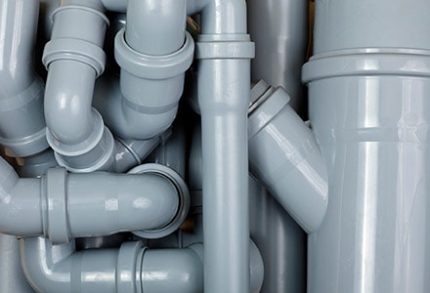
For example, installation of pipes at an too sharp angle, or, conversely, at an insufficient slope; a large number of creases, a too small cross-section of the pipes, the presence of gaps between the pipes, incorrectly selected parts or lack thereof.
Problem # 5 - Life and Care
Long pipe life can cause blockages. But PVC pipes are practically not subject to such wear.
This is more true for cast iron pipes, as their inner surface has some roughness. It is susceptible to corrosion and sediment from passing debris and sewage remains on it. Over time, the sediment accumulates and is compressed, so the throughput of the pipes will decrease.
Lack of necessary care and planned cleaning of plumbing is also a common cause of traffic jams. For cast iron pipes, such cleanings must be carried out once every 2-3 months, and for plastic pipes at least once a year. Having determined the cause of the blockage, it is necessary to find out the place of its dislocation.
Clog location
Knowing the exact location of the cork is important in order to find the right tool for sewer pipe cleaning. First you need to open all the taps: in the bathroom, in the kitchen, in the shower, flush the toilet. Where water will not merge well into pipes, a characteristic odor will appear, and there is a cork.
If the water stagnates in one place: for example, in a kitchen sink or in the toilet, then this is a local problem, if the water leaves poorly at all points, then the whole system is clogged.
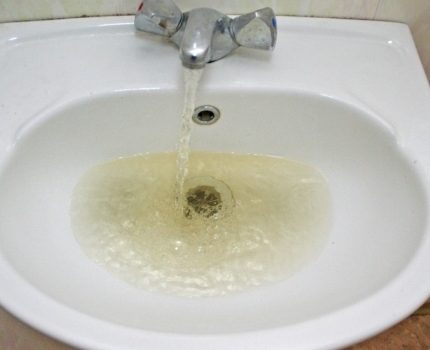
Having decided on the place and cause of the blockage, we will consider how to deal with traffic jams.
Cleaning Methods and Tools
Depending on the degree of pollution and the location of the blockage, we will help you find a working method. Next, we will focus on folk, chemical and mechanical sewer cleaning methods.
Folk remedies for quick cleaning
Try pouring 2-3 liters of boiling water into the sink if the problem is only in a stuck bar of soap.For quick cleaning of more complex blockages, but not compressed fat or dirt, you can use different mixtures based on soda. Before using such a mixture, first clean the surface of the drain and wipe it dry.
Soda and salt. A dry mixture of salt and soda (1 1/2 cups each) should be poured into the drain and left for at least 10 hours, and preferably all night.
Soda and Vinegar. Mix half a cup of vinegar and the same amount of soda, the resulting mixture should be carefully poured into the drain, block it with a cork and leave at least 40 minutes, a maximum of several hours.
When pouring vinegar - immediately close the cap. If you cannot achieve maximum tightness, then the result will be zero. After cleaning in this way, be sure to flush the drain plenty of hot water.
Soda and boiling water. Dilute 1 cup of soda in 3 cups of boiling water and pour a drain hole with such a solution.
Calcined soda. 150 g of baking soda need to be heated for 15 minutes in a cast-iron pan. Then cool and dilute with cold water, fill the resulting mixture with stock. After 2 hours, rinse with boiling water.
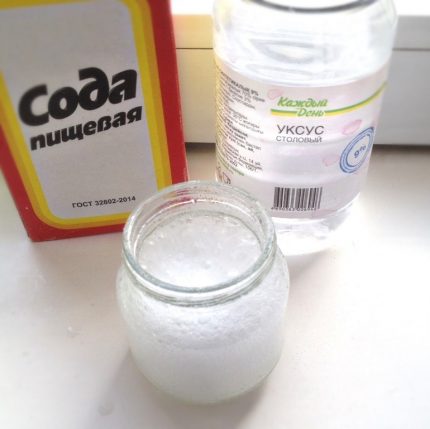
Also, with a small blockage, ordinary washing powder copes. Pour 2-3 scoops or 1 cup of powder into the drain and put hot water for 5 minutes, or you can just pour 2 buckets of hot water. If all else fails, then use purchased means.
High-speed chemicals
If you need a quick result, use household cleaning. A large assortment of how to clean the sewer in the house is available on store shelves.. Such preparations can be: acidic and alkaline, dry or in granules, gels and liquids.
Carefully read the instructions before buying, because different means are used for different types of pipes and blockages. Pay attention to the manufacturer's recommendations - if this is a prophylactic or only against fatty plugs, then do not use it in other cases. Otherwise, you risk damaging or completely ruining the sewer or plumbing.
Alkaline products will help get rid of fatty blockages in the kitchen, and acid substances are more used for garbage jams in the bathroom. After all, here, the cause of a clogged sewage system, as a rule, is soap or hair.
Which sewer cleaning agent If you wouldn’t choose, be sure to observe safety measures: use gloves, do not bend over the drain when you fall asleep. Never use acid and alkaline products at the same time.
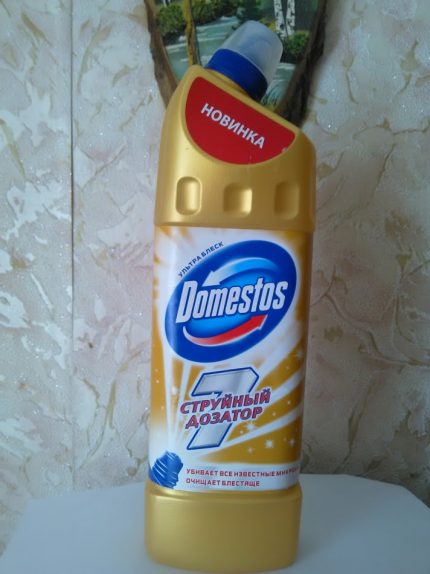
Here are some of the best-selling drugs for dealing with different types of traffic jams:
- Mole and its variations - turbo or professional gel orbitch. A universal remedy that is perfect for both prevention and elimination of blockages that have appeared. You can fill in or fall asleep all night, leaving the window open.
- Tyreth Turbo - According to customer reviews, it best copes with fat jams in the kitchen. It has a pungent odor.
- Domestos - This "universal soldier" is familiar to every housewife. It can be left all night. Suitable for all pipes and sinks, in addition to corks, kills germs and plaque.
- Mister Muscle - universal drug, copes with any traffic jams. Its active substances act quickly enough - about 1-2 hours, although experts recommend pouring it overnight. No odor or hazardous fumes.
- BugsPothan - A powerful chemical tool that can cope even with old traffic jams.It is necessary to use it as carefully as possible due to the active reaction and the pungent odor: pour on an outstretched gloved hand, turn your head away, put on a mask. If you have an allergy, then it is better not to use such a drug.
When using any of the described means, be sure to arm yourself with rubber gloves and, if possible, a protective mask. Also, do not overexpose the drug beyond the specified time, because this will only harm the pipes.
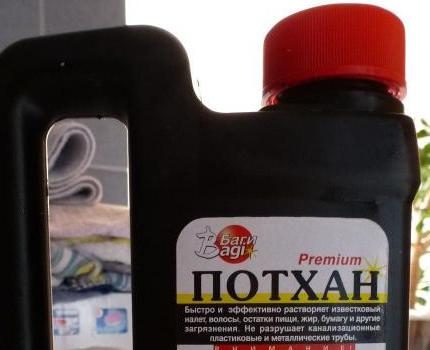
After working with any chemistry, be sure to ventilate the room. If after using such preparations the water still does not come off, then use plumbing supplies.
Overview of technical methods
If neither folk methods nor chemical agents have helped to cope with traffic jams in the sewers, then it remains to test technical methods. Such tools include plumbing tools that will help to cope with blockages of any complexity.
Method No. 1 - we will use a plunger
This simple device consists of a rubber bowl and a wooden handle. If two washes are installed, then two plungers must be used simultaneously. When there is no second plunger, close the other drain tightly with a damp cloth.
To clean, install the plunger so that it completely covers the drain, pour a little water into the sink. Then you should vigorously move the handle up / down, at least 10-15 times. After that, the water should completely merge with a characteristic sound. If this does not happen, then repeat your actions.
The plunger can not be used on wall mounted washbasins - they will not withstand pressure, in addition, the device will not break through an old compressed blockage. About how to delete sink drain, you will learn from our recommended article.
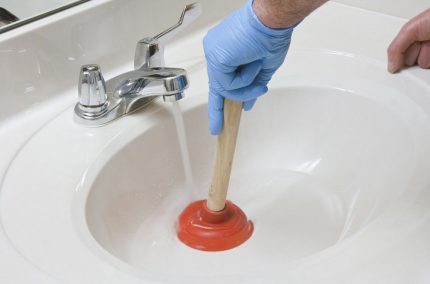
Please note that after such cleaning, the pipes must beclean up with a cable or chemical means and rinse with plenty of warm water.
Method number 2 - clean the siphon
A standard bottle siphon has a diameter of 30-45 mm - the smaller it is, the faster it clogs. The removable part, which resembles a bowl in shape, is easy to unscrew.
Before cleaning the siphon, place a basin of water under the sink and put on gloves. Then carefully unscrew it, with a special cable or wire, remove all unnecessary. Wash the siphon, dry and screw into place. Check your work: pour water into the sink and if it leaves quickly, there is no more clogging.
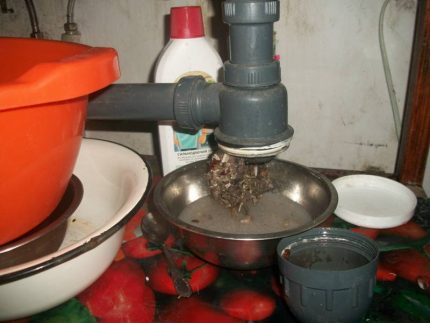
If you have installed a siphon of a different type, for example, pipe, corrugated or triple, then proceed to the next method.
Method No. 3 - take a plumbing cable
If you have plastic pipes installed, then any plumbing cable should be used as carefully as possible.
In other cases, follow these instructions:
- Place a basin or bucket under the sink.
- Separately, draw water into any container - to clean the cable.
- Then unwind the siphon. Rinse and clean it.
- Grasp the handle of the cable, if it is not, then make it from a bent ring.
- Insert the end of the device into the pipe. Then start to rotate it slowly, pushing it deeper - to do this, rotate the handle. Do this as carefully as possible so as not to damage the pipe.
- With a certain frequency, take it out and clean it of impurities in a previously prepared container. If you come across a seal, then this is a congestion.
- Screw on a clean and dry siphon. Check all details.
- Rinse the piping with boiling water.
Such simple repeated actions will help to cope even with compressed blockages.
If there is no cable, then as an alternative, you can use a thick wire, forming a hook at its end.
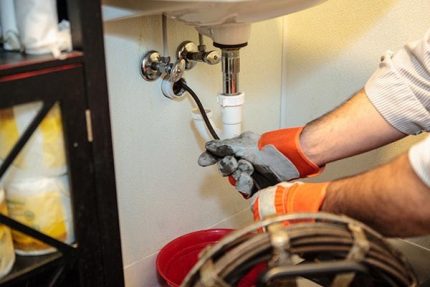
Sometimes a cable can be constructed from a metal hanger: with a tool, such as a wire cutter, you need to trim its ends so that you get a hook to remove dirt.
Method No. 4 - we resort to hydrodynamics
This is the most effective way for "severe" cases. It is used only by professionals. For example, for working with solid plugs in the middle of a pipe, for cleaning sewers in private houses or main sewers. A hydrodynamic professional device is used to clean pipes with a diameter of 5 to 150 mm.
Cleaning is done thanks to a tube with several types of nozzles for spraying water under high pressure - up to 200 atmospheres. Both hot water and cold are used.
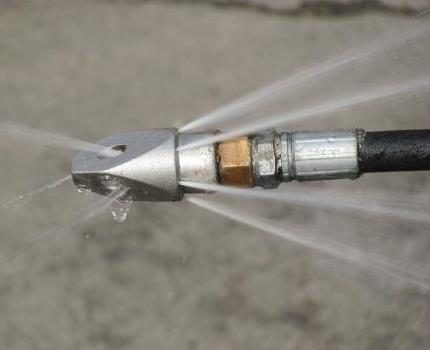
Which of the technical methods of dealing with sewage waste to use, it's up to you. If the blockage is old or the pipes are very old, then use the all-in-1 method.
Method No. 5 - we solve the problem radically
A universal or prefabricated method will help in the fight against even the most “harmful” blockage. The method consists of several steps.
If the first in sewer cleaning if it didn’t help, then proceed to the following, and so on, until a trace remains of the cork:
- preparation - flush the water, remove leftover food and debris, dry the drain;
- pour soda with boiling water into a dry drain;
- use a plunger, then a cable;
- fill all night with a chemical agent, for example, Mr. muscle or Mole;
- pour a large amount of boiling water into the drain, about 1 bucket or open the tap for a few minutes.
This method will almost certainly save you from a boring problem.
How to protect the sewer from blockages?
Below we give some tips that in the future will help to avoid the formation of junk jams:
- Every 2-3 months, do easy cleaning of pipes with folk remedies or daily, at the end of the day, let boiling water run through the pipes.
- Before washing dishes, remove leftover food from plates, wipe off excess fat, and throw it in the trash.
- Do not throw hygiene products, wet or paper towels, cat litter, sand, or inorganic waste into the toilet.
- Never clean shoes in the sink. Try to remove as much dirt as possible above the bin.
- After washing floors and very dirty surfaces, pour water into the toilet, but not into the sink.
- Put a paper bucket in the toilet, do not save water for flushing, do not throw technical and construction waste into the toilet - glue, sand, cement, as well as large organic waste. To clean the toilet, use special anti-plaque products.
Pay attention to the technical means that will secure pipes from garbage congestion.
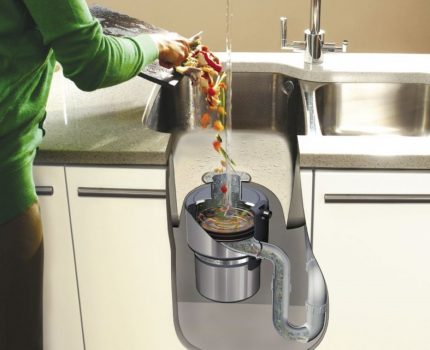
It is necessary to install special nets for each drain: kitchen sink, shower, bath. They will trap organic waste, partially grease, hair, sand, thread and other small items.
To prevent the formation of fatty deposits, use a special device:grease trap. The device is available for industrial and domestic use and consists of two sections. Principle of action: drains passing through the filter system in the first container are cleaned of large debris.In the second, special filters clean water from grease.
For grinding organic waste under the sink setgarbage grinder. It is mounted under the sink, connected to the sewer and connected to the network. The device can work instead of a siphon. It is recommended that the outlet be placed not under the sink in order to protect it from getting wet.
Compactgarbage chopper It will cope with all waste, from vegetable scraps, seeds, ending with bones from poultry, fish. Do not throw hair, pieces of fabric, wool into it, otherwise the device will simply break.
All described technical devices are grids,grease trap, garbage grinder After use, wash thoroughly and keep clean.
Introduces methods and technological features of eliminating blockages in the toilet next article, in which all the options tested in practice are disassembled and described in detail.
Conclusions and useful video on the topic
Video # 1. How to prevent blockages using improvised means:
Video # 2. Learning to use the plunger for pipe cleaning:
Video # 3. The cable is the first assistant for cleaning the sewers in cottage:
Video # 4. How to use a cable to clean the sewer in the apartment:
Now you know how to deal with any kind of blockage, not only in the apartment, but also in a private house. Sometimes you need to apply several methods to achieve the desired result. But armed with our simple tips, you can easily overcome the difficulties that have arisen.
Please write comments in the block below, ask questions and post photos on the topic of the article. Tell us about how you managed to quickly and effectively get rid of clogging in the sewer system. It is possible that you own a special, only known to you method that is worth sharing with site visitors.

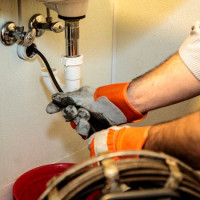 How to eliminate clogging in pipes at home: the best means and methods of cleaning
How to eliminate clogging in pipes at home: the best means and methods of cleaning 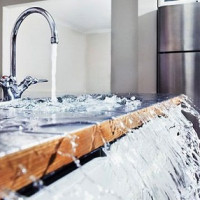 How to clean sewer pipes in a private house: varieties of blockages and methods of cleaning
How to clean sewer pipes in a private house: varieties of blockages and methods of cleaning 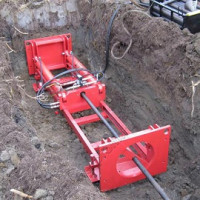 How to puncture pipes: technical rules and expert advice
How to puncture pipes: technical rules and expert advice 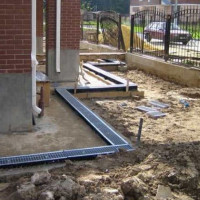 Drainage in a private house: device methods, schemes + main stages of construction
Drainage in a private house: device methods, schemes + main stages of construction 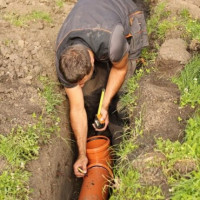 What should be the slope of the sewer pipe according to construction standards
What should be the slope of the sewer pipe according to construction standards 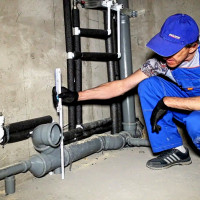 Do-it-yourself replacement of sewage in the apartment: detailed instructions for replacing the riser and pipes
Do-it-yourself replacement of sewage in the apartment: detailed instructions for replacing the riser and pipes  How much does it cost to connect gas to a private house: the price of organizing gas supply
How much does it cost to connect gas to a private house: the price of organizing gas supply  The best washing machines with dryer: model rating and customer tips
The best washing machines with dryer: model rating and customer tips  What is the color temperature of light and the nuances of choosing the temperature of the lamps to suit your needs
What is the color temperature of light and the nuances of choosing the temperature of the lamps to suit your needs  Replacement of a geyser in an apartment: replacement paperwork + basic norms and requirements
Replacement of a geyser in an apartment: replacement paperwork + basic norms and requirements
Several sections give advice on using boiling water (with or without additives?). I would like to understand how safe it is for plastic pipes and siphons? For example, I had a case when a plastic part (faucet / shower switch) in a mixer melted and deformed. After that incident, I am somehow wary of too hot water.
It is absolutely safe. Plastic pipes confidently keep the temperature up to 140 degrees, they begin to melt at 175. That is, they can be melted with water only in a vaporous state, and boiling water will not cause harm.
All these kitchen siphon cleaners are not particularly difficult. But cleaning at the junction with the general access and apartment pipes can be problematic. By the way, I was puzzled by the advice in which it is proposed to clean the cast-iron sewer pipes every 2-3 months. I would like clarification: how is it possible to disassemble them, or what? If it is intended to pour some kind of “Mole” into them, then it simply leaks out without having in any way cleaned the walls of the pipe.
As for cast iron, it all depends on the layers that form in it over many years of use. If you do not clean the pig-iron pipe for many years, it will have deposits of a couple of centimeters, which almost completely blocks the flow of water.Here, any remedy will be up to the bulb. It will help only by breaking through with a cable, and even better by hydraulic breakdown. But if as a prophylaxis, then the mole will perfectly cope with minimal deposits of fat in both plastic and cast iron.
Hello! It will leak if you continue to pour water, rinsing the pipe from the product. But if you flood at night, for example, then on small blockages, which just become the reason for the accumulation of large deposits, it will linger and dissolve. It is also recommended to rinse with hot water. If you do not lower large household waste, napkins and toilet paper into the drain, then such preventive measures will last for a long time.